My
Organs, My Life: The
Advent of the Nord C2
|
|||||||
|
The Nord C2, the pedals,
speakers,
other debris,
was something like $6500
a vast expenditure, but nothing
compared to the priceless
offerings of Allen,
Rodgers,
or Johannus.![[8]](eight.png) ... And there are (were?) monstrously-expensive
(€50,000?) Roland “home” electronic organs which are
so
super
... And there are (were?) monstrously-expensive
(€50,000?) Roland “home” electronic organs which are
so
super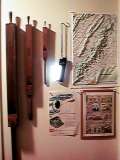 exquisitely top-drawer
I didn’t detect them for months
in my wandering quest — apparently in the
same priceless class as Allen et al except, judging by
the
invisibility cloaking to commoners such as myself, even more
so — but they did
become
more visible, if still priceless, with the conjuration Atelier,
apparently no longer with us.
... In my simple ignorance, I suspect the
Allen etc. offerings are even more
expensive, apparently routinely running into the $100,000s. ... But
that
is the wonder
and beauty
of the priceless ideal:
no need to worry my little head about all that. ... Well @ 6/15,
“Dwight Allen” was selling his TQ321
Allen used for $26K; which is getting closer to the human
scale of
things....
exquisitely top-drawer
I didn’t detect them for months
in my wandering quest — apparently in the
same priceless class as Allen et al except, judging by
the
invisibility cloaking to commoners such as myself, even more
so — but they did
become
more visible, if still priceless, with the conjuration Atelier,
apparently no longer with us.
... In my simple ignorance, I suspect the
Allen etc. offerings are even more
expensive, apparently routinely running into the $100,000s. ... But
that
is the wonder
and beauty
of the priceless ideal:
no need to worry my little head about all that. ... Well @ 6/15,
“Dwight Allen” was selling his TQ321
Allen used for $26K; which is getting closer to the human
scale of
things....
So my Nord Imperium really is the working man’s baroque-sampled / clonewheel / MIDI-theater home instrument. ... And in my own perfect storm of modernity and stark contrast, my chosen organ-shopping venues Amazon.com, Sweetwater and occasionally Musiciansfriend display their prices on their web pages....
|
 The
Transcendent
Beauty of the Thing Itself
The
Transcendent
Beauty of the Thing ItselfThe UPS guys came in
the
chilly Christmassy night with an eerie echo of my years-ago DK40:
the stops are off
when the indicator
is lit at the top;
they make sounds when lit at the bottom.
... Just like the levers
on the DK40
— and presumably
most of the stop tabs in the world, which are off
when up
— and indeed the Hammond drawbars, no doubt imitating the real
thing — but this
confused myself and a co-shopper at the organ flea market so long ago
where
I first met the DK40.
She was one of
those astonishingly competent keyboardists of the older persuasion, but
 I put
all
the levers up and it made no sound. ... She said she
didn’t
do
anything. ... Then we figured-out we had to put them down
and she launched into an impromptu concert I could never hope to
emulate in my wildest dreams. ... But she had not the room nor the
wherewithal — nor the bad judgment — to get
a home
organ, used or new, and
I have all those things....
I put
all
the levers up and it made no sound. ... She said she
didn’t
do
anything. ... Then we figured-out we had to put them down
and she launched into an impromptu concert I could never hope to
emulate in my wildest dreams. ... But she had not the room nor the
wherewithal — nor the bad judgment — to get
a home
organ, used or new, and
I have all those things....
I wondered why electronic organs needed enormous
speaker
systems,
when I could play
organ recordings
on a little hifi box; I actually had a cranky letter to that effect
printed
in The Diapason,
I think. ...
And the answer is — you don’t. ...
At least, I
didn’t —
until
the pedals came. ... It’s really a question of loudness.
That is, you can play an organ recording relatively softly
without blowing-out your hifi speakers. But apparently, even with my
humble aspirations, that’s not good-enough for the home organ, and
I craved louder.
Which, as I
learned after some travail, won’t work with hifi speakers or,
actually,
without a subwoofer.![[2]](two.png)
... Anyway, here are my usual cranky complaints:
1. The mechanism for assembling the Nord volume pedal, which is included with the PK27 pedals, was dubious. Six self-tapping screws were provided, which I believe were so hard to screw-in because they’re supposed to prevent people from over-tightening into the plastic....
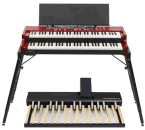
2. But a much worse defect revealed itself after a few weeks, which I will ruthlessly expose to the organ-buying public: the Nord volume pedal mounting on the pedalboard is too far forward, troubling for that odd pedal accidental, and which I eventually fixed with abusive hole drilling.

3. Less troubling but still stupid was the short
MIDI cable provided for the pedals. I’m not
sure
it’s
even enough for their
set-up  ,
but it
definitely
wasn’t
long-enough to go around my beautiful plywood table. ... Chintzy. ...
So
I wound-up using an antique MIDI cable
from
the archives,
which I quaintly soldered-together one dark and
stormy night so many weary years ago....
,
but it
definitely
wasn’t
long-enough to go around my beautiful plywood table. ... Chintzy. ...
So
I wound-up using an antique MIDI cable
from
the archives,
which I quaintly soldered-together one dark and
stormy night so many weary years ago....
On the bright side, I am pleased with Nord’s pedal design. ... It’s clever — or to put it another way, the “standard” — Hammond or AGO — is dumb: nobody plays the back of the pedals much — well, except maybe Cameron Carpenter — so Nord just left ’em off, producing a lighter, more compact unit.
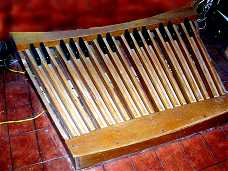
I suspect — armed with adamantine ignorance —
that
the
traditional form is based on primitive mechanical considerations
of antique pipe organs, with the Hammond simply the first of many
electronic
imitations. ...
So today’s
pedals may have a lighter physical load but my
under-powered hi-fi sadly distorted when I trod the mighty
pedalboard, light and compact as it might be.
... I couldn’t blame Nord; the headphones sound fine. ... So I
turned the bass down a bit on the Nord’s built-in tone
control and launched into a frightening rendition of Das
Alte Jahr Vergangen Ist, and everything became
calm and
serene. ... But I got some speakers.![[2]](two.png)
For my next trick, I fecklessly wallowed in
Bill Irwin’s The
Best
Christmas
Songs Ever organ book,
with its 52 Hammond organ registrations
in a little chart, stuffing the occasional suspect into the Nord’s
program memory as I wandered through the more alluring
selections, me ’n’ my Nord virtual “B3”.
...
When I got to an inspiring Irwin arrangement of I’ll
Be
Home For Christmas, it felt just
like my poor departed Hammond
Commodore
— but better.
... The Commodore
itself was a clonewheel
with, however,
a genuine
 rotating
speaker, or at least an immense thing with some kind of
rotating
element; I could hear it go ’round and ’round. ... But the
Nord does an excellent
job evoking the
throbbing through my motionless transducers....
rotating
speaker, or at least an immense thing with some kind of
rotating
element; I could hear it go ’round and ’round. ... But the
Nord does an excellent
job evoking the
throbbing through my motionless transducers....
And so after all my high-minded musings on the Nord’s baroque stops, what really got me was the B3 schmaltz! ... Even ’though my latter day organ infatuations approximately started with the incomparable theater organist George Wright, who generally provides a much higher-minded shmaltz. ... And even ’though the only thing “real” pipe organists hate more than electronic organs is Hammond electronic organs. ... But still I believe in my heart that schmaltz is the secret ingredient in the Wright CDs (that + an endearing and bizarre humor) and I think it’s what the Hammond got for thousands of humble Christmas parlors through the wandering years, including mine. ... I want pipe and theater organs to last forever, but I also want the Hammond sound to go on; to throb through the ages, bringing joy and unease to audiences everywhere. ... In the ATOS Journal once, a letter repeated a theater organ concert-goer’s misgivings, seemingly applicable to all this music: “I like [it], but I’m not sure I should”. ... It’s so tawdry; and so beautiful....
 ...
And
Silver
Bells
...
...
And
Silver
Bells
...And now at last the dream of ages: I can play “Silver Bells” with realistic bell sounds!
...
It
is a fact that as a youth I wished to be an
electronic  organ engineer. Not for me the
space suit or cowboy horse;
no I wanted an electronic organ, and I thought it would be wonderful to
design them. Presumably an artifact of my never-consummated Schober
obsession. ... Sadly, I actually wound-up designing industrial
packaging machines, ridiculously and inadvertently like my father
before me....
organ engineer. Not for me the
space suit or cowboy horse;
no I wanted an electronic organ, and I thought it would be wonderful to
design them. Presumably an artifact of my never-consummated Schober
obsession. ... Sadly, I actually wound-up designing industrial
packaging machines, ridiculously and inadvertently like my father
before me....
Anyway, one of the truly wonderful things some electronic organs could do was make bell-like sounds, and the intensity of this wonder increases by vast multipliers in the Christmas season. ... With this in mind, I’ve bought a few kiddie keyboards with chime sounds over the years, but they were too cheesy even for me. ... And no reverb....
But
now that I had my Nord with its three
(i.e., including the pedals) MIDI-emitting
keyboards, I plotted more
sounds:
bells, perhaps eventually even theater
organ sounds.
... I was so behind the
times I thought we still
bought “sound
modules”, but of course we don’t, or only on Ebay,
or perhaps
the
new
luxury-retro Roland
Integra-7 for $2000 — which is really too pricey for a few
bells.
...
But no, today we feed our MIDI keyboards into our computers, where they
are
magically transformed into
beautiful
sounds and music! ... But how? ... Minutes
of 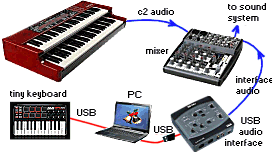 googling
produced only obscurity....
googling
produced only obscurity....
And it came to me in a vision (fairly obvious to be sure): I would use my Reaper DAW software + a laptop + a little MIDI USB keyboard, and make bell noises to accompany the Nord B3! ... With a Reaper track configured the right way — recording enabled, MIDI input, other stuff I forget; actually I just copy and mutilate an existing Reaper track I know already works — I can emit ravishing bell-like noises when I poke the tiny keys, using Reaper’s “ReaSynth” VSTi for the bells + the kindly Kjaerhus Audio’s free “Classic Reverb” I got from the Reaper site so the bells’d keep up with the Nord reverb I drenched my schmaltz in. ... Latency through windows vanilla audio is usually unacceptable, at least to accompany the instantaneous Nord sounds, hence the USB gadget....
So
my computeristic dreams have come true, and my bells ring sweet and
true
but it was all just a prelude, as it turned-out, to endless
elaboration,
culminating
in the beautiful virtual
theater organs.
| And
in despair I bowed my head: “There is no peace on earth,” I said “For hate is strong, and mocks the song Of peace on earth, good will to men.” |
Then
pealed the bells more loud and deep: “God is not dead, nor doth He sleep; The wrong shall fail, the right prevail, With peace on earth, good will to men.” |
| — from I Heard the Bells on Christmas Day, Henry Wadsworth Longfellow | |

The days passed, and another Christmas, and the power of my clone B3 schmaltz weakened. ... Sure, for an iconic song like I’ll Be Home For Christmas it’s still compelling, but my favored-schmaltz choice has now drifted to the Miditzer — which has the advantage of being schmaltzy and despised by experts. ... But the quintessential B3-ness has become a little wearying; as indeed does the B3, sometimes, regrettably, in what we call real life. ... Speaking of which, we do all know I’ll Be Home is a song about not being home for xmas? ... A war-time existential plaint? ... By those dark days it was a cliché of jingoistic military optimism that armies would be home by Christmas, a meme lodged in the popular consciousness by World War I. The WWII audience knew it was bogus, but that only added a universal poignancy to the song. ... The final whimper “if only in my dreams” is sometimes neglected in modern covers, so gloomy and all, but fits so perfectly my latter-day home organ project, my fond hopes and foolish dreams....
 The
Eternal
Schmaltz
The
Eternal
SchmaltzAnd then finally I realized the Hammond schmaltz was really borrowed from the theater organs that came before, in an arguably degraded form although that’s quibbling since decent society abhored both. ... But the characteristic Hammond vibrato tone is almost certainly intended to be like a theater tibia in full tremolo — on steroids, cruder, stronger. ... But I of course prefer the more refined tibia, and also the Hammond notoriously lacks the theater organ’s “snarling reeds” — quoting the Schober record. But the two instruments are still obviously in a line of succession, so as well as classical pipe organs, Hammond also hastened the eclipse of theater organs — the already-dwindling bunch surviving the talkies. ... The Hammonds in their turn were followed by my beloved post-war home organs, co-existing for a time, most with vibratoed tibia-esque flutes of varying intensity and offensiveness, including my beautiful DK40 with its sweet ravishing almost-tibia. And cohorts of geezers would remember their golden days in the movie palaces, with the organ, and then they died off, keyboards got too cheap, and the tibia was all but silent for years. ... Until our latter-day virtual paradise....
 The Rhythm Machine?
The Rhythm Machine?This took a little while — about 7 years — but I finally tried integrating a supremely important schmaltz element — the cheesy rhythm machine — into the Nord Imperium — echoing the beloved home organ emporia of my dreamy youth, where the maestro would demo away something deeply meretricious, but always including a pronounced rhythm accompaniment if the unit had any such, inasmuch as that was a major selling point. ... My rhythm machine, the antique (~1985) Roland TR-505, is much-despised by the EDMeratti, and indeed I got the thing originally as I set out on my pointless journey into electronic music where, like so many of my beloved acquisitions, it did nothing.
But for the beloved 60s/70s organs of my youth, the TR-505
would’ve been cadillac
class, providing the cheesiest
shmaltz — Laura
with a Latin beat! — timbales!
— oh be still my heart before such wonders in my time. ... My
sense of
rhythm is even worse than my keyboard agility, but that’s not
the point! ...
The idea
is to fake
it with wondrous technology, in this case antediluvian, hence more beautiful.
And I’d really like
one of those organs with
 the
built-in rhythm, but both the rhythm and the stops were probably
inferior to my current lash-up ... and indeed both my Commodore
and the DK40 had
rudimentary
rhythm accompaniment, I think, but I guess I never used them much....
the
built-in rhythm, but both the rhythm and the stops were probably
inferior to my current lash-up ... and indeed both my Commodore
and the DK40 had
rudimentary
rhythm accompaniment, I think, but I guess I never used them much....
I got so enthused, I was inspired to equip-up my beloved chord organ (1950?). ... My first idea was my departed father’s casio mt-68 (1983), which would function as a 2nd manual and an authentically-cheesy drum machine! ... But I’d have to somehow move the music stand probably, and it really wouldn’t be right — the chord organ shouldn’t have a second manual. ... And then I realized I had a Yamaha DD5 (’89?) purchased for a trifle on my junk store adventures, what has a built-in speaker. ... Amazingly, its original two drum sticks are still stored in a special receptable on the bottom; just in case. ... And I didn’t even think of my Korg EMX1! — although its presets are a little edgy for the total-schmaltz effect I crave, not to mention the massive armored steel case....
These
pitiful drum machines in those dark days were optimized for MIDIing
/ recording patterns (i.e. drum pads), so you could rock out your couldn’t-afford-drums
awful band — an area I somehow never explored adequately.
But
there was always a shameful need for in-the-can rhythms which the DD5
supports a little better (compared to the TR-505)
with the built-in speakers and the “intro” button, which is
a way to get a bit of pitiful variation
into the robotic beat.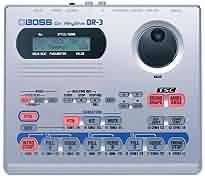
But the Nord Imperium embraces inauthenticity, so I decided to replace the TR-505 with a $pace-age Boss DR-3 — more/better buttons and mind-numbing complexity. ... And it doesn’t have built-in speakers or drumsticks like the DD5. And the cheap amazon manual is in Japanese! ... But when it gets going in randomish “auto” mode, it’s got lots of beat variations — and a light show! ... Take that, 1985! ... I notice my unique talents require turning down the tempo quite a bunch....
Cheap Junk?
And then after leaving the Boss DR-3 on all the time — so at least I’d be entertained a tiny bit by its lights ’n’ screen — the stupid LCD display went south, so I swapped it with the still working-but-too-challenging one I had stuck on my chord organ, and left the poor little thing’s power switch off....
And I think I’ve learned something! — the drums shouldn’t be controlled with the main organ volume, but should be adjusted independently. With the beautiful chord organ that was more-or-less mandatory, but I could do it either way with the Nord, but the volume-control-less route is better. The drums are probably best for loungey schmaltz — September Song? — where the organ volume varies for tawdry emotional effect, but the beat should just march on. On the other hand, schmaltzy Xmas medlies, with bells and wild volume/tempo variations (Adeste Fidelis into Silent Night) probably wouldn’t go so good with the drum machine anyway....
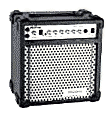 And then
I realized there should be both
volume-pedal and static volume, so one can set a minimum
fixed level and also a level that increases/decreases with the pedal —
which I could easily achieve with
my dangerous nest of mixers and other junk. ... And
then I got an
additional
DR3, but half-price, apparently shipped from Japan in a boat, which I
will inflict on my beloved Hammond Chord
Organ using a past-sell-by-date guitar
amp. I hope ... I think.
And then
I realized there should be both
volume-pedal and static volume, so one can set a minimum
fixed level and also a level that increases/decreases with the pedal —
which I could easily achieve with
my dangerous nest of mixers and other junk. ... And
then I got an
additional
DR3, but half-price, apparently shipped from Japan in a boat, which I
will inflict on my beloved Hammond Chord
Organ using a past-sell-by-date guitar
amp. I hope ... I think.
... And then, finally, I must admit, after a few years of failure, I am defeated, and the beautiful rhythm machines still can’t make my wretched performances stay on the beat! ... An inadequacy of yore, and the beautiful drums will probably remain silent on into the future....
And then, pitifully, my beautiful DR3 drum machine got cranky and turned-off its LCD! ... Fortunately I had two of them, so I replaced the Imperium’s with the one from the chord organ, neither of which I could ever play with, and someday I may unscrew the broken one and try to find a contrast or reset or something ... but of course, why bother?
But I made sure to leave the working DR3 off, which I am assuming was what killt its adorable LCD. ... But then it occurred to me the precious Nord might be subject to the same hideous malady, so after ridiculous effort untangling years of power cords I figured-out how to turn the beloved mechanism off also, leaving the laptop and the MIDI software happily running. And all these years I had assumed a rigorous power ordering was required, i.e. Nord-on and then computer/MIDI junk — but it was just another delusion. Indeed violating the sequence in the past had failed, but it was presumably the MIDI junk; of course the super-professional Nord is resistant to power flipping. ... And of course my curatorial preservation attentions will probably/eventually be some kind of mortal blow to the innocent Nord as the weary years fall over themselves....
So then I moved my beloved yamaha DD5 drum machine back to my chord organ where it is obviously more period-authentic — although still off by a few decades. ... And. I still can’t play to rhythm worth a darn, but there it is at least, and doesn’t need any stinking amplifier....

|

The Nord C2 pipe organ emulation has an “authentic” swell pedal: as opposed to its B3 and combo emulations, only the swell manual in its pipe organ emulation is affected by the volume pedal, which is monstrously authentic. ... To control the volume of both pipe organ manuals, I installed a Behringer FCV100 volume-control pedal (i.e., on the output audio system). As the imperium progressed through ever-more baroque elaborations so to speak, the Nordic original sin/feature became inoperative in my intricate plans, since I wanted the extra volume control anyway for the virtual theater organs (with their uninspiring MIDI volume controls) as well as my xmas bells before it....
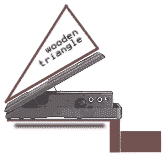 Sadly,
the
Behringer FCV100 pedal itself is hardly ideal for the purpose:
as well as requiring a power-supply purchase, it is
designed
for flat
“on-the-floor” operation, rather than perched up next to the
Nord’s volume
pedal. So I fabricated an inclined plane thing and
attached it to the top of the Behringer. But as the months
passed, all the high-tech Owenlabs construction
techniques have been
Sadly,
the
Behringer FCV100 pedal itself is hardly ideal for the purpose:
as well as requiring a power-supply purchase, it is
designed
for flat
“on-the-floor” operation, rather than perched up next to the
Nord’s volume
pedal. So I fabricated an inclined plane thing and
attached it to the top of the Behringer. But as the months
passed, all the high-tech Owenlabs construction
techniques have been  deployed in the cause — postal tape, Funtak,
wallboard screws,
hot melt, and
the
ever-popular scraps of wood from the garage — oh wait, almost forgot
velcro!
— fashioning a “shell”
for
the thing so it’ll be a good angle more-or-less to stand-up without
falling off the pedal board chassis. ... Originally, the
scheme
was bogus because the
Behringer pedal controlled the Nord’s reverb as well as the organ
sound, but that was obliviated
in further reverb
tweakery.
... And I must sadly report
after a year or so the FCV100
makes
very occasional static clicks when in a bad mood. ... And then later I
realized I made it stick up too
much,
and shortened the wood triangle from 3’’ to 2’’,
and
now it’s harder
to get to
FF
— instead of pp
as it
was before.
deployed in the cause — postal tape, Funtak,
wallboard screws,
hot melt, and
the
ever-popular scraps of wood from the garage — oh wait, almost forgot
velcro!
— fashioning a “shell”
for
the thing so it’ll be a good angle more-or-less to stand-up without
falling off the pedal board chassis. ... Originally, the
scheme
was bogus because the
Behringer pedal controlled the Nord’s reverb as well as the organ
sound, but that was obliviated
in further reverb
tweakery.
... And I must sadly report
after a year or so the FCV100
makes
very occasional static clicks when in a bad mood. ... And then later I
realized I made it stick up too
much,
and shortened the wood triangle from 3’’ to 2’’,
and
now it’s harder
to get to
FF
— instead of pp
as it
was before.
Pipe organ or B3, the C2’s volume pedal appears to be
some kind
of
afterthought as
per my informative pictures  where Nord’s puffery
looks
a lot like the B3, no?
...
But a musiciansfriend’s picture reveals how it obviously intrudes
over
the pedals,
just
as it did on my lovely unit, presumably because of some uniquely
Swedish mishap with drills, holes, or who knows.
where Nord’s puffery
looks
a lot like the B3, no?
...
But a musiciansfriend’s picture reveals how it obviously intrudes
over
the pedals,
just
as it did on my lovely unit, presumably because of some uniquely
Swedish mishap with drills, holes, or who knows.
The last picture is of my final triumph, where I stuck the thing back where it belongs or perhaps a little further — but anyway where I want it. ... For Nord to duplicate my magnificent accomplishment all they need do is remanufacture the volume unit with an assortment of mounting holes, and drill an additional threaded hole for the right thumbscrew in the pedal unit — which of course I was afraid to do — so the assortment of holes won’t require advanced metal schlockery....
 ...
Well Maybe
...
Well MaybeAnd then the stumbling years passed into the glorious time of covid, and I moved my Behringer FVC100 volume pedal forwards ... I didn’t actually move it up as far as the original shameful Nord pedal, but still.... Fortunately my Behringer installation is equipped with vastly-adjustable velcro so I can move it any which way whenever I feel like it....
And at last, as the covid plague has apparently conquered my feet, I removed my beautiful wooden triangle entirely — which, oddly, wasn’t that difficult! — I can even put it back on without that much effort! — but now it sits in naked pedalness, too far forward, and softer — ’cause my foot has to strain to push the thing to the louder position.
... But that too was just a further misstep, and eventually I put the triangle back, in the further (mis-) adventuress of the FCV100 pedal....
Sunday 6/8/25 10:17 am